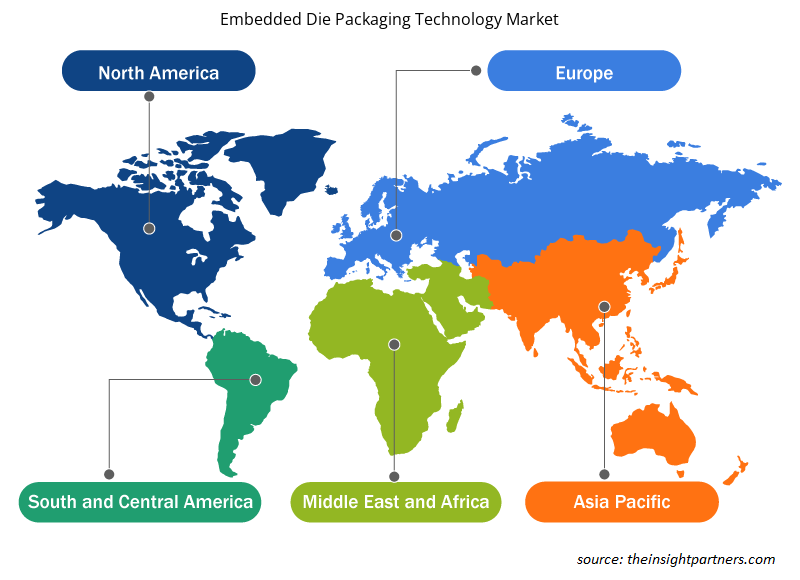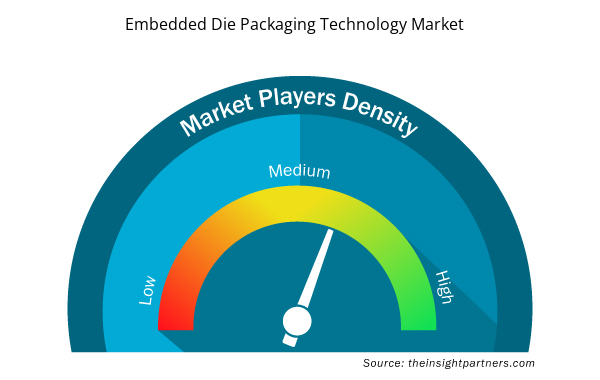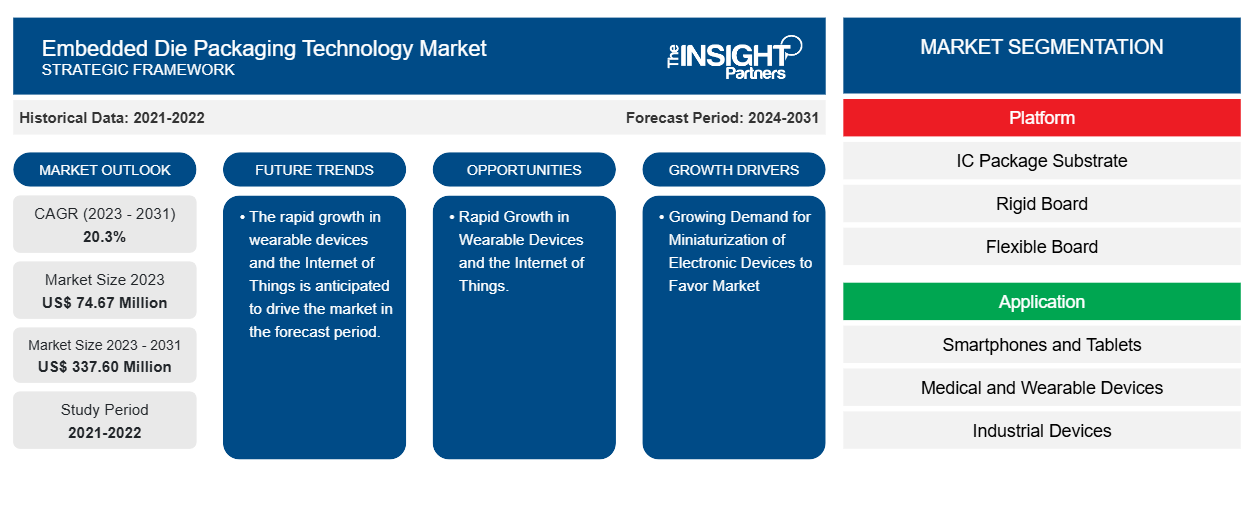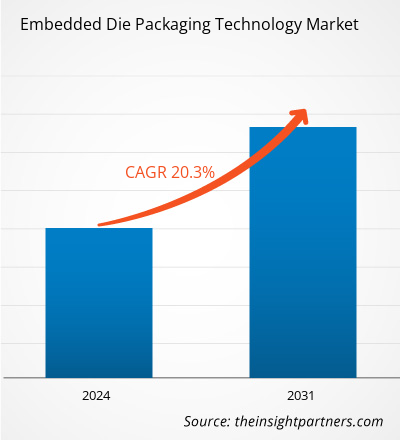組み込みダイパッケージング技術市場は、2023年の7,467万米ドルから2031年には3億3,760万米ドルに達すると予測されています。市場は2023年から2031年の間に20.3%のCAGRを記録すると予想されています。電子機器の小型化に対する需要の高まりと組み込みダイパッケージング技術の開発の高まりが、市場の主要な推進力とトレンドとなる可能性があります。
埋め込みダイパッケージング技術市場分析
組み込みダイ パッケージング技術市場は、世界的に著しい成長を遂げています。電子機器の小型化に対する需要の高まりと、組み込みダイ パッケージング技術の発展の高まりが、この市場の成長を支えています。さらに、スマートフォンや自動車機器の性能向上に対する需要の高まり、ウェアラブル デバイスやモノのインターネットの急速な成長も、トレード プロモーション管理ソフトウェア市場の成長を後押しする要因の 1 つです。
埋め込みダイパッケージング技術市場の概要
埋め込みダイ パッケージは、ほとんどのパッケージ タイプとは異なります。通常、多くの IC パッケージでは、デバイスは基板の上に配置されます。基板は、システム内のデバイスとボードの間の橋渡しとして機能します。
要件に合わせてレポートをカスタマイズする
このレポートの一部、国レベルの分析、Excelデータパックなど、あらゆるレポートを無料でカスタマイズできます。また、スタートアップや大学向けのお得なオファーや割引もご利用いただけます。
- このレポートの主要な市場動向を入手してください。この無料サンプルには、市場動向から見積もりや予測に至るまでのデータ分析が含まれます。
組み込みダイパッケージング技術市場の推進要因と機会
電子機器の小型化の需要が高まり、市場が好調
電子機器の小型化に対する需要の高まりが、市場を牽引しています。電子機器の小型化には、より小型の集積回路 (IC) により多くのトランジスタ ノードを組み込むことが含まれます。その後、IC は目的のシステムまたはデバイス内でインターフェイスされ、組み立てられたシステムは目的の機能を実行できるようになります。この技術は、より小型でありながら強力になっています。さらに、ダイを基板内に埋め込むことで、電子パッケージの全体的なフットプリントが大幅に削減されます。これは、モバイル デバイス、ウェアラブル、医療用インプラントなど、スペースが貴重であるアプリケーションに特に有利です。
ウェアラブルデバイスとモノのインターネットの急速な成長。
ウェアラブル デバイスとモノのインターネットの急速な成長により、今後数年間、組み込みダイ パッケージング技術市場には多くのチャンスが生まれると予想されています。ウェアラブル デバイスは、物理世界とデジタル世界の境界を結び付ける態勢が整っています。拡張現実メガネは、個人の周囲に情報を重ねて表示し、リアルタイムのナビゲーション、翻訳支援、さらには都市のパーソナライズされたツアーを提供します。組み込みダイ パッケージング技術は、多くの IC パッケージのウェアラブル デバイスに役立ちます。デバイスは基板の上に配置されます。
組み込みダイパッケージング技術市場レポートのセグメンテーション分析
組み込みダイ パッケージング技術市場分析の導出に貢献した主要セグメントは、プラットフォーム、アプリケーション、および業界です。
- プラットフォームに基づいて、組み込みダイパッケージング技術市場は、IC パッケージ基板、リジッドボード、フレキシブルボードに分かれています。IC パッケージ基板セグメントは、予測期間中に大きな市場シェアを占めると予想されます。
- アプリケーションに基づいて、組み込みダイパッケージング技術市場は、スマートフォンとタブレット、医療およびウェアラブルデバイス、産業用デバイス、セキュリティデバイス、およびその他のアプリケーションに分かれています。スマートフォンとタブレットのセグメントは、予測期間中に大きな市場シェアを占めると予想されます。
- 業界別に見ると、市場は家電、ITおよび通信、自動車、ヘルスケア、その他の業界に分かれています。航空宇宙および防衛は、予測期間中に大きな市場シェアを占めると予想されます。
地域別埋め込みダイパッケージング技術市場シェア分析
組み込みダイパッケージング技術市場レポートの地理的範囲は、主に北米、アジア太平洋、ヨーロッパ、中東およびアフリカ、南米および中米の 5 つの地域に分かれています。
北米は、組み込みダイパッケージング技術市場を独占してきました。北米地域のさまざまな業界でのハイテク採用の傾向が、組み込みダイパッケージング技術市場の成長を後押ししています。デジタルツールの採用の増加、政府機関による高い技術支出、電子機器の小型化の需要の高まり、組み込みダイパッケージング技術の開発の増加などの要因が、北米の組み込みダイパッケージング技術市場の成長を牽引すると予想されます。さらに、米国とカナダの先進国では研究開発に重点が置かれているため、北米のプレーヤーは技術的に高度なソリューションを市場に投入せざるを得ません。さらに、米国には、革新的なソリューションの開発にますます重点を置いている組み込みダイパッケージング技術市場のプレーヤーが多数います。これらすべての要因が、この地域の組み込みダイパッケージング技術市場の成長に貢献しています。
埋め込みダイパッケージング技術市場地域別分析
予測期間を通じて組み込みダイ パッケージング技術市場に影響を与える地域的な傾向と要因は、Insight Partners のアナリストによって徹底的に説明されています。このセクションでは、北米、ヨーロッパ、アジア太平洋、中東、アフリカ、南米、中米にわたる組み込みダイ パッケージング技術市場のセグメントと地理についても説明します。

- 埋め込みダイパッケージング技術市場の地域別データを入手
埋め込みダイパッケージング技術市場レポートの範囲
| レポート属性 | 詳細 |
|---|---|
| 2023年の市場規模 | 7,467万米ドル |
| 2031年までの市場規模 | 3億3,760万米ドル |
| 世界のCAGR(2023年~2031年) | 20.3% |
| 履歴データ | 2021-2022 |
| 予測期間 | 2024-2031 |
| 対象セグメント | プラットフォーム別
|
| 対象地域と国 | 北米
|
| 市場リーダーと主要企業プロフィール |
|
埋め込みダイパッケージング技術市場のプレーヤー密度:ビジネスダイナミクスへの影響を理解する
エンベデッド ダイ パッケージング テクノロジー市場は、消費者の嗜好の変化、技術の進歩、製品の利点に対する認識の高まりなどの要因により、エンド ユーザーの需要が高まり、急速に成長しています。需要が高まるにつれて、企業は提供内容を拡大し、消費者のニーズを満たすために革新し、新たなトレンドを活用し、市場の成長をさらに促進しています。
市場プレーヤー密度とは、特定の市場または業界内で活動している企業または会社の分布を指します。これは、特定の市場スペースに、その規模または総市場価値と比較して、どれだけの競合相手 (市場プレーヤー) が存在するかを示します。
組み込みダイパッケージング技術市場で事業を展開している主要企業は次のとおりです。
- アムコーテクノロジー株式会社
- ASEグループ
- AT & S オーストリア テクノロジー & システム技術アクティエンゲゼルシャフト
- 株式会社フジクラ
- ゼネラル・エレクトリック・カンパニー
- イナネオンテクノロジーズAG
免責事項:上記の企業は、特定の順序でランク付けされていません。

- 組み込みダイパッケージング技術市場のトップキープレーヤーの概要を入手
埋め込みダイパッケージング技術の市場ニュースと最近の動向
埋め込みダイ パッケージング技術市場は、重要な企業出版物、協会データ、データベースなどの一次調査と二次調査後の定性的および定量的データを収集することによって評価されます。埋め込みダイ パッケージング技術市場におけるいくつかの開発を以下に示します。
- ASEは、自動車用電子機器の組み込みダイパッケージングを推進しています。バックエンドハウスのASEテクノロジーは、主に自動車用電子モジュールの処理に適用される「Advanced Embedded Active System Integration(ASI)」と呼ばれる自社開発の組み込みダイテクノロジーを持っています(出典:ASE企業ウェブサイト、2024年5月)
埋め込みダイパッケージング技術市場レポートの対象範囲と成果物
「組み込みダイパッケージング技術市場規模と予測(2021〜2031年)」レポートでは、以下の分野をカバーする市場の詳細な分析を提供しています。
- 範囲内でカバーされるすべての主要市場セグメントについて、世界、地域、国レベルでの組み込みダイ パッケージング技術市場の規模と予測。
- 組み込みダイ パッケージング技術市場の動向、および推進要因、制約、主要な機会などの市場動向。
- 詳細な PEST/ポーターの 5 つの力と SWOT 分析。
- 主要な市場動向、世界および地域の枠組み、主要プレーヤー、規制、最近の市場動向を網羅した組み込みダイ パッケージング技術市場分析。
- 市場集中、ヒートマップ分析、主要プレーヤー、および組み込みダイ パッケージング技術市場における最近の動向を網羅した業界の状況と競争分析。
- 詳細な企業プロフィール。
- 過去2年間の分析、基準年、CAGRによる予測(7年間)
- PEST分析とSWOT分析
- 市場規模価値/数量 - 世界、地域、国
- 業界と競争環境
- Excel データセット


- Lyophilization Services for Biopharmaceuticals Market
- Small Molecule Drug Discovery Market
- GNSS Chip Market
- Aesthetic Medical Devices Market
- Online Exam Proctoring Market
- Gas Engine Market
- Flexible Garden Hoses Market
- Maritime Analytics Market
- Space Situational Awareness (SSA) Market
- Sodium Bicarbonate Market

Report Coverage
Revenue forecast, Company Analysis, Industry landscape, Growth factors, and Trends

Segment Covered
This text is related
to segments covered.

Regional Scope
North America, Europe, Asia Pacific, Middle East & Africa, South & Central America

Country Scope
This text is related
to country scope.
よくある質問
The expected CAGR of the embedded die packaging technology market is 20.8%.
The global embedded die packaging technology market is expected to reach US$ 337.60 million by 2031.
The rapid growth in wearable devices and the Internet of Things is anticipated to drive the market in the forecast period.
The key players holding majority shares in the global embedded die packaging technology market are Amkor Technology, Inc., ASE Group, AT & S Austria Technologie & Systemtechnik Aktiengesellschaft, Fujikura Ltd., General Electric Company, INANE-ON TECHNOLOGIES AG, Microsemi, SCHWEIZER ELECTRONIC AG, SHINKO ELECTRIC INDUSTRIES CO.; LTD, Taiwan Semiconductor Manufacturing Company, Limited.
The growing demand for the miniaturization of electronic devices and rising developments in embedded die packaging technology are some of the factors driving the embedded die packaging technology market.
North America is anticipated to dominate the embedded die packaging technology market in 2023.
Trends and growth analysis reports related to Electronics and Semiconductor : READ MORE..
The Insight Partners performs research in 4 major stages: Data Collection & Secondary Research, Primary Research, Data Analysis and Data Triangulation & Final Review.
- Data Collection and Secondary Research:
As a market research and consulting firm operating from a decade, we have published and advised several client across the globe. First step for any study will start with an assessment of currently available data and insights from existing reports. Further, historical and current market information is collected from Investor Presentations, Annual Reports, SEC Filings, etc., and other information related to company’s performance and market positioning are gathered from Paid Databases (Factiva, Hoovers, and Reuters) and various other publications available in public domain.
Several associations trade associates, technical forums, institutes, societies and organization are accessed to gain technical as well as market related insights through their publications such as research papers, blogs and press releases related to the studies are referred to get cues about the market. Further, white papers, journals, magazines, and other news articles published in last 3 years are scrutinized and analyzed to understand the current market trends.
- Primary Research:
The primarily interview analysis comprise of data obtained from industry participants interview and answers to survey questions gathered by in-house primary team.
For primary research, interviews are conducted with industry experts/CEOs/Marketing Managers/VPs/Subject Matter Experts from both demand and supply side to get a 360-degree view of the market. The primary team conducts several interviews based on the complexity of the markets to understand the various market trends and dynamics which makes research more credible and precise.
A typical research interview fulfils the following functions:
- Provides first-hand information on the market size, market trends, growth trends, competitive landscape, and outlook
- Validates and strengthens in-house secondary research findings
- Develops the analysis team’s expertise and market understanding
Primary research involves email interactions and telephone interviews for each market, category, segment, and sub-segment across geographies. The participants who typically take part in such a process include, but are not limited to:
- Industry participants: VPs, business development managers, market intelligence managers and national sales managers
- Outside experts: Valuation experts, research analysts and key opinion leaders specializing in the electronics and semiconductor industry.
Below is the breakup of our primary respondents by company, designation, and region:

Once we receive the confirmation from primary research sources or primary respondents, we finalize the base year market estimation and forecast the data as per the macroeconomic and microeconomic factors assessed during data collection.
- Data Analysis:
Once data is validated through both secondary as well as primary respondents, we finalize the market estimations by hypothesis formulation and factor analysis at regional and country level.
- Macro-Economic Factor Analysis:
We analyse macroeconomic indicators such the gross domestic product (GDP), increase in the demand for goods and services across industries, technological advancement, regional economic growth, governmental policies, the influence of COVID-19, PEST analysis, and other aspects. This analysis aids in setting benchmarks for various nations/regions and approximating market splits. Additionally, the general trend of the aforementioned components aid in determining the market's development possibilities.
- Country Level Data:
Various factors that are especially aligned to the country are taken into account to determine the market size for a certain area and country, including the presence of vendors, such as headquarters and offices, the country's GDP, demand patterns, and industry growth. To comprehend the market dynamics for the nation, a number of growth variables, inhibitors, application areas, and current market trends are researched. The aforementioned elements aid in determining the country's overall market's growth potential.
- Company Profile:
The “Table of Contents” is formulated by listing and analyzing more than 25 - 30 companies operating in the market ecosystem across geographies. However, we profile only 10 companies as a standard practice in our syndicate reports. These 10 companies comprise leading, emerging, and regional players. Nonetheless, our analysis is not restricted to the 10 listed companies, we also analyze other companies present in the market to develop a holistic view and understand the prevailing trends. The “Company Profiles” section in the report covers key facts, business description, products & services, financial information, SWOT analysis, and key developments. The financial information presented is extracted from the annual reports and official documents of the publicly listed companies. Upon collecting the information for the sections of respective companies, we verify them via various primary sources and then compile the data in respective company profiles. The company level information helps us in deriving the base number as well as in forecasting the market size.
- Developing Base Number:
Aggregation of sales statistics (2020-2022) and macro-economic factor, and other secondary and primary research insights are utilized to arrive at base number and related market shares for 2022. The data gaps are identified in this step and relevant market data is analyzed, collected from paid primary interviews or databases. On finalizing the base year market size, forecasts are developed on the basis of macro-economic, industry and market growth factors and company level analysis.
- Data Triangulation and Final Review:
The market findings and base year market size calculations are validated from supply as well as demand side. Demand side validations are based on macro-economic factor analysis and benchmarks for respective regions and countries. In case of supply side validations, revenues of major companies are estimated (in case not available) based on industry benchmark, approximate number of employees, product portfolio, and primary interviews revenues are gathered. Further revenue from target product/service segment is assessed to avoid overshooting of market statistics. In case of heavy deviations between supply and demand side values, all thes steps are repeated to achieve synchronization.
We follow an iterative model, wherein we share our research findings with Subject Matter Experts (SME’s) and Key Opinion Leaders (KOLs) until consensus view of the market is not formulated – this model negates any drastic deviation in the opinions of experts. Only validated and universally acceptable research findings are quoted in our reports.
We have important check points that we use to validate our research findings – which we call – data triangulation, where we validate the information, we generate from secondary sources with primary interviews and then we re-validate with our internal data bases and Subject matter experts. This comprehensive model enables us to deliver high quality, reliable data in shortest possible time.


 このレポートの無料サンプルを入手する
このレポートの無料サンプルを入手する